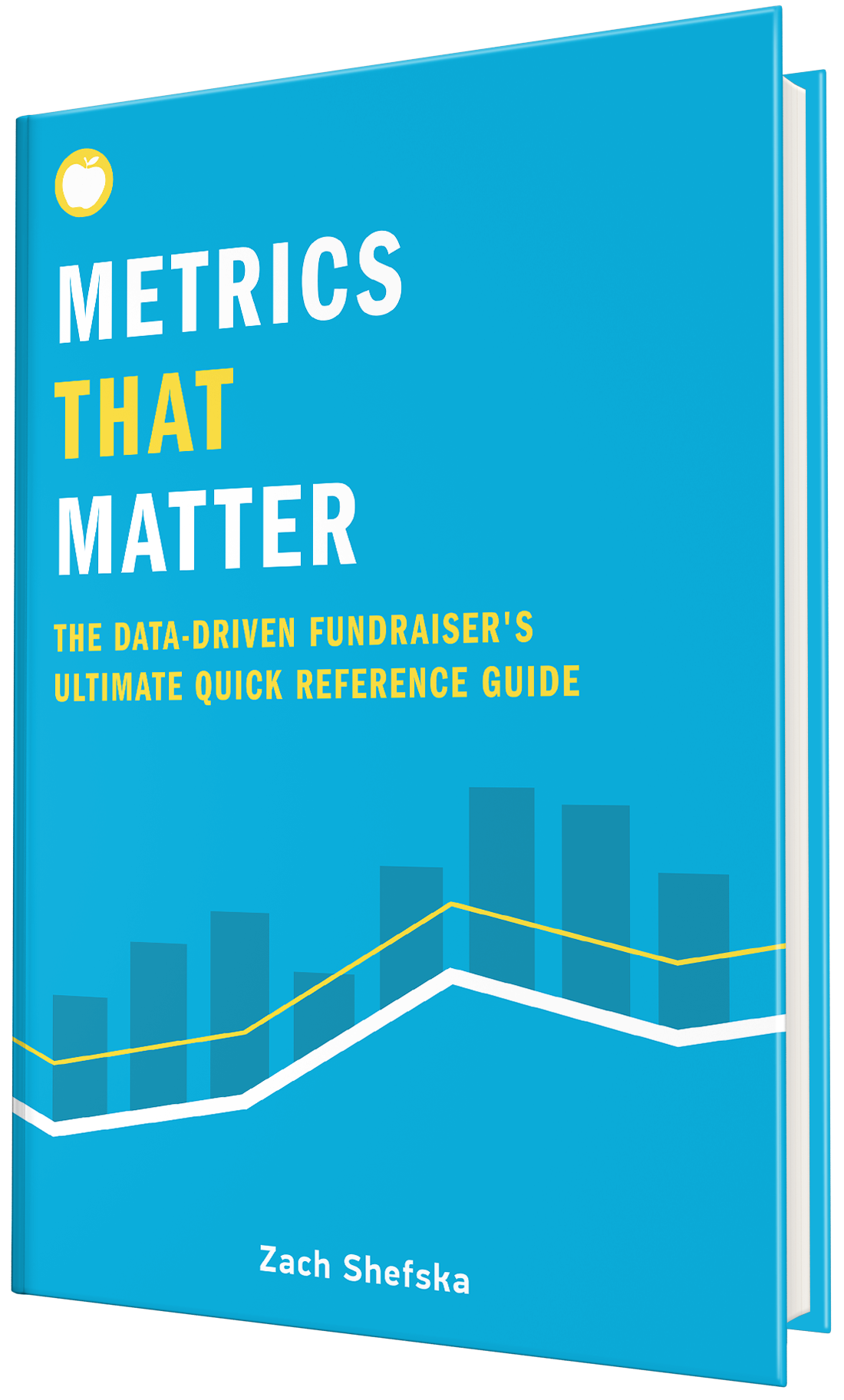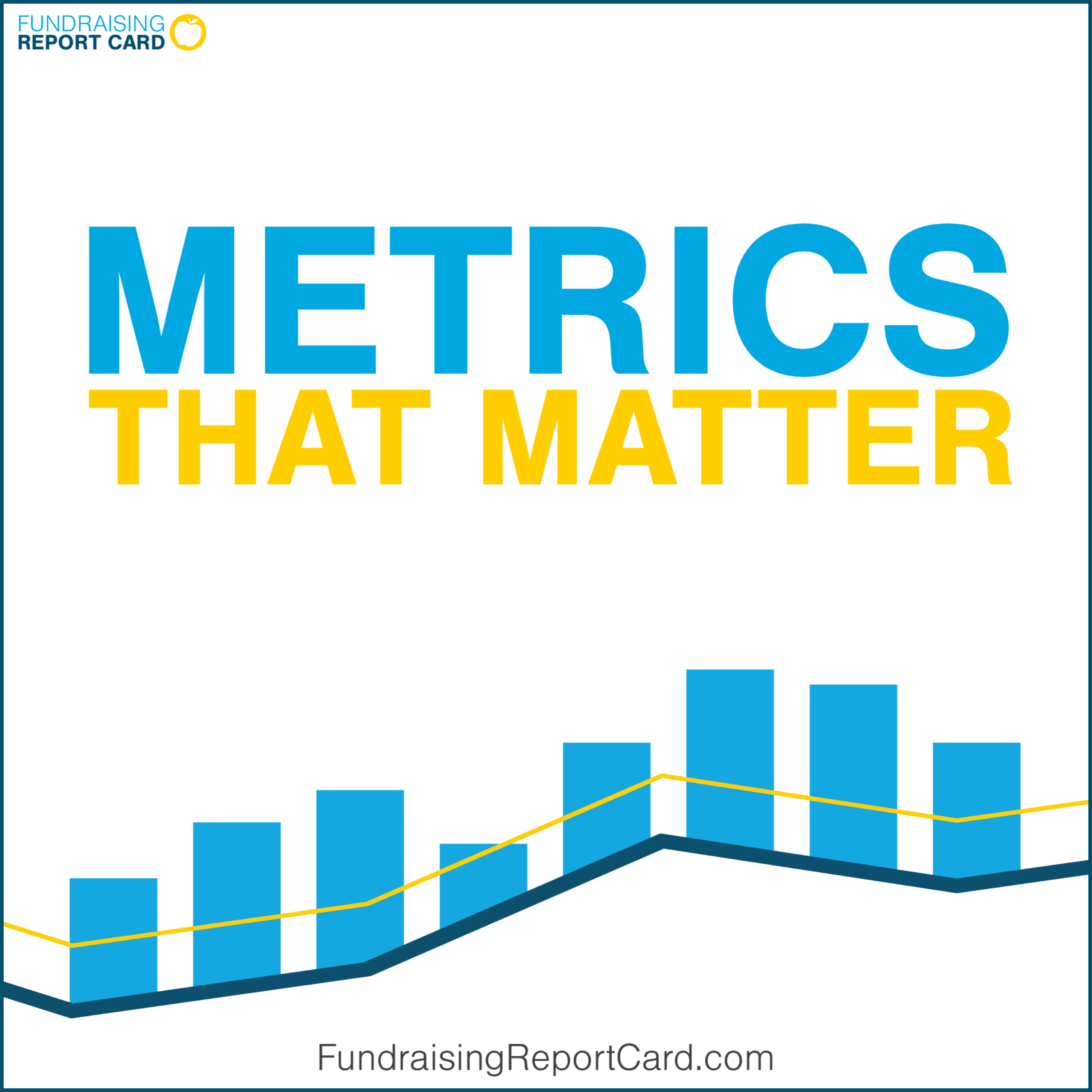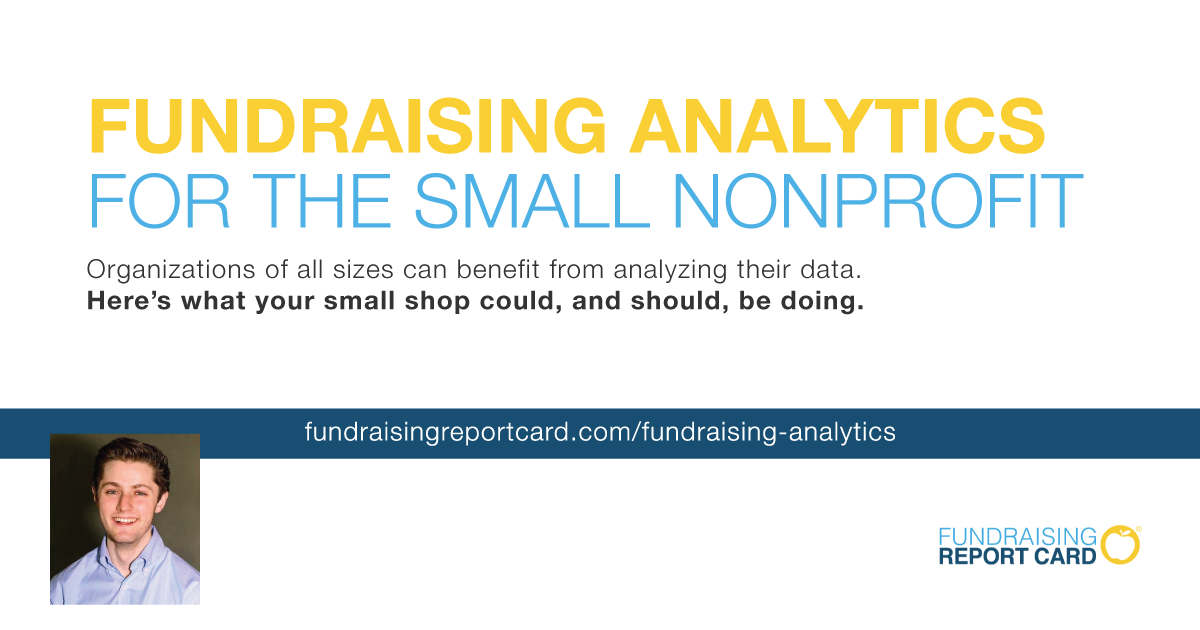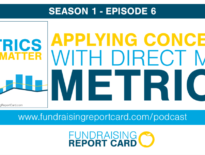Google search “
big data,” and you should expect
big results.
Do you see what I see? 403,000,000 possible links to click on.
Wow.
“Data” as a concept is like a black hole. Where do you even begin? As nonprofit professionals we’re trained and equipped with tools that help us build relationships, establish compelling cases for support, and ultimately further our organization’s mission—we’re not data scientists.

But, more frequently than not we’re bombarded with marketing that suggests we should be. “Your for-profit peers are analyzing customer data to improve ROI, you should too!” This sentiment, which I come across all too often on webinars and at conferences is great, unfortunately, it’s really difficult to execute.
Contemplating data from the perspective of a small grassroots nonprofit is even more challenging. If you’re reading this, you likely wear many hats at your organization. Fundraising may not even be one of your primary responsibilities, instead it might be something you simply tend to from time to time. How then (and more importantly, why) should you begin the process of learning a foreign concept like “data analytics?” Justifying this answer with, “I heard about it on a webinar” is not good enough. Your time is too valuable to try new things on a whim.
Instead of focusing on the abstract, let’s focus on reality. Data doesn’t need to be intimidating, and understanding your organization’s treasure trove of information can have a legitimate and positive impact on your bottom line. Let’s simplify the discussion around data, identify a handful of areas where it can truly be meaningful for us, and cut out the rest of the noise.
Why data should inform our fundraising strategies

Third Space Studio, a niche consulting firm run by Meredith Emmett and Heather Yandow produces some of the most compelling “small” nonprofit research in our sector. Their annual
Individual Donor Benchmark Project (IDBP) provides incredibly necessary insight into the realities and trends seen among smaller nonprofit organizations.
Large annual research reports such as the Giving USA annual report get a lot of attention, but their results aren’t particularly “actionable” or accurate for smaller grassroots organizations. The Individual Donor Benchmark Project, plus Fundraising Report Card’s
Live Benchmarks fill in this void.
One of the most compelling outcomes from the IDBP’s research was the conclusion that “having a fundraising plan is the key indicator for successful fundraising.”
Without a plan, the research suggests, an organization will not achieve as much as they were capable of achieving.
This forces us to address the question, “How do you come up with a fundraising plan?” You could “use your gut,” or “do what we’ve always done,” but neither of those techniques are reliable long-term solutions. Let’s use data to help drive the planning and strategy process—that is one area where it can, and should shine.
Measuring certain metrics, understanding historical trends in donor behavior, and entering the realm of what is called “descriptive analytics” can help you determine what strategy to take. Once we have a strategy, we can implement tactics. And, once our tactics have been put into place, we can measure their effectiveness by looking back at the metrics that guided our initial strategy decision. This process of using data for decision making takes us away from relying on gut feelings and the “status quo,” and forces us to develop a “feedback loop,” where our activities are informed and measured by real numbers.
Which metrics should I measure?

This leads us to our next question, “Which metrics should I measure?” In order to inform your fundraising strategy there are a few key metrics you’ll want to know.
I’ve written extensively in the past about a variety of meaningful metrics and why you should measure them, but is is important to keep in mind that there is no “one size fits all” solution. Below we’ll review two commonly measured and useful fundraising metrics — donor retention rate and donor lifetime value.
Donor retention rate
Simply put, donor retention rate is the number of donors you keep with respect to the number you had at the start of a given period of time. This does not count new donors, but it will included upgraded and downgraded donors.
To calculate donor retention rate you’ll take all retained donors in a year and divide that by all donors from the prior year. This number, multiplied by 100, is your donor retention rate.
This equation is pretty simple, and you may have even seen it covered on other fundraising publications and websites:
Donor Retention Rate = (Retained Donors in 2017 ÷ All Donors in 2016) x 100
You can think of retention rate as a measure of how well your organization is developing relationships with its constituents. The higher the rate at which donors maintain their year-over-year giving, the better your organization is likely doing building and cultivating relationships with, and that are meaningful to, those supporters.
It’s important to know and measure your overall donor retention rate, but it is even more important to keep track of segmented retention rates. For example, how well is your organization retaining first-time donors? This would be the rate at which first-time donors from last year being are retained the next year.
What about repeat donors? At what rate are retained donors from last year being retained again this year?
Having insight into your organization’s donor retention rate, and its related, segmented retention rates will have major implications on strategic decisions moving forward.

For example, an organization I volunteer with analyzed their donor retention rates after spending thousands of dollars to increase donor acquisition. We calculated their first-time donor retention rate over the last three years and it was incredibly clear in which years the organization acquired, and lost, many first-time donors. First-time donor retention rates plummeted from 22% in 2016 to 8% in 2017.
What does this mean? It suggests that a lot of the new donors acquired in 2016 didn’t renew in 2017. Why is this important? It highlights the negative implications of investing in acquisition without a retention strategy. Unfortunately for this organization, they were paying the price of not being prepared with a 12 month welcome series which could have kept their first-time donors engaged, and their retention rates higher.
Having donor retention rate on hand, though, made it clear to the organization that they needed a donor retention strategy in addition to a donor acquisition plan going forward. What would your organization’s data look like if you were to review these segmented retention rates? Knowing that answer will inform your strategy for retaining donors moving forward!
Donor lifetime value
Donor Lifetime Value, or LTV, is a prediction of how much money your organization can expect to receive from a donor during the lifetime of their giving (from first donation to last donation, acquisition to lapse). This information can help you make important decisions about your fundraising budget and where to allocate resources.
The higher your donor lifetime value, the better. A high LTV means you can expect to receive a lot of revenue from your donors before they lapse. This means you can afford to spend a bit of money on appeals, campaigns, support, and so on to acquire others and retain them.
The equation for LTV is relatively simple, but it requires a few other metrics that can be tricky to calculate. To calculate your LTV you’ll need to know your average donor lifespan (how many years a donor maintains their giving), average donation amount, and frequency of donation (the number of gifts a donor makes in one year).
Using that information, the calculation looks something like this:
LTV = Lifespan × Average donation amount × (Total # of donations ÷ Total # of donors)
Getting your hands on the input metrics (lifespan, average donation amount, and frequency of giving) can be challenging, but they are certainly worthwhile. Although we won’t dive too deep into it in this post,
you can read my suggestions in another post about how to pair LTV with donor acquisition cost (DAC), to begin the process of measuring how “profitable” your fundraising initiatives really are. For example, you can compare LTV with DAC to determine which of your acquisition channels is bringing in the most “profitable” donors. This concept is pretty advanced and involved, but please know that calculating LTV is well worth the time it takes!
Similarly to donor retention rates, we’ll be interested in segmented values of LTV. For example, what is the lifetime value of a donor that came from a Facebook ad? How does that value compare to the LTV of a donor that first contributed at your local event? Calculating LTV by segment allows you to begin to compare long-term effectiveness of different fundraising campaigns and initiatives.
Knowing lifetime value is incredibly important, but knowing how different segments of your supporters compare on this key metric can be revolutionary for your planning and strategy.
How do I interpret my metrics?

After identifying which metrics you are going to measure and calculating them, you are left with interpretation—essentially answering the question, “What do these numbers mean?” Your acquisition and retention strategies should be based around the answer to this question.
If you can, you’ll want to calculate at least five years of retention rates and lifetime value metrics. From this you should be able to identify trends — peaks and valleys — in both categories.
Data is meant to help drive a discussion (that’s why data visualization, another topic for another article, is so important). At your organization, with your team, you’ll want to discuss why retention rates peaked in 2014 (for example), and why lifetime value was lower in 2016 (again, as an example). What events and activities could have taken place in those years to influence your key metrics?
After analyzing your historical trends you should be able to identify some of the crucial events or activities that played a role in how the numbers came to be. Good! We’ll use this knowledge of what happened in the past to inform aspects of future strategy (if you’re interested in Google searching later, this is called descriptive analytics). If you think it was the specific campaign you sent out in 2014 that boosted retention rates you might want to consider incorporating that campaign again this year.
This is why data is critical for planning future strategies — by discussing what the numbers mean, we see the bigger picture. Data without narrative is useless, data with a story is compelling. In order to craft your story you will review trends over the past five years among your key metrics. You can think of this as benchmarking your organization against itself — what is the best we have historically been able to perform? How did we do that?
It may be tempting to compare your organization’s benchmarks to other organizations’, but without understanding the norm for your organization, interpretations of the findings will be incomplete or inaccurate when you bring other organizations’ data into the fold. Once the story of your organization’s data is clear, then you can propose the question, “How does this compare to similar organizations?”
This is often a question that organizational leadership asks. The director of a community foodbank might ask, “How well are we doing compared to the other foodbank?” for example.
There are a few resources out there that can help you address this question. One such resource is
Live Benchmarks, a project I have been working on for well over a year now. Plus there is the Individual Donor Benchmark Project mentioned earlier. If there are other, similar nonprofits in your area you could connect with them and see if you could benchmark against one another to learn what is working and what is not. Regardless of what data you find to benchmark against, please remember to benchmark against yourself first (historically), and then look to your peers.
We’ll use all of this context to help drive strategy. If you are doing well relative to the past few years, then keep doing what you are doing. If you are doing poorly relative to the past few years you may want to change course. If you are doing well relative to your peers you may want to consider sharing your strategies and tactics with other organizations who aren’t performing quite as well. If you are doing worse, then it might be a sign to try different approaches.
Comparison and discussion is how we interpret and make data actionable. Leverage both while going through this process to truly create a data-driven fundraising plan at your organization.
Resources to help you
We’re not leaving you high and dry on this quest to use data at your grassroots development shop… far from it! All I’ve learned about leveraging data in our sector has stemmed from building Fundraising Report Card about two years ago. If you don’t know by now, Fundraising Report Card is a free data analysis tool used by thousands of of organizations across the world.
In addition to Fundraising Report Card, you have a few tools in your toolbox to help calculate the metrics we mentioned above:
Applying this at your shop
Data isn’t that bad afterall, is it? Sure, that Google search with four hundred million results is a tad bit overwhelming, but once you get into it, data doesn’t have to be a nebulous concept.
If you’re heading back to your desk after reading this article keep these key takeaways in mind:
-
- Fundraising metrics are great, they help us answer our questions and guide strategy. But too many metrics and not the right ones simply become noise. They cloud our vision and actually get in the way.
- At your small shop it is incredibly important to understand why you’re looking at the numbers before you get in too deep. Always keep in mind the question you are trying to answer.
Related
 Third Space Studio, a niche consulting firm run by Meredith Emmett and Heather Yandow produces some of the most compelling “small” nonprofit research in our sector. Their annual Individual Donor Benchmark Project (IDBP) provides incredibly necessary insight into the realities and trends seen among smaller nonprofit organizations.
Large annual research reports such as the Giving USA annual report get a lot of attention, but their results aren’t particularly “actionable” or accurate for smaller grassroots organizations. The Individual Donor Benchmark Project, plus Fundraising Report Card’s Live Benchmarks fill in this void.
One of the most compelling outcomes from the IDBP’s research was the conclusion that “having a fundraising plan is the key indicator for successful fundraising.”
Without a plan, the research suggests, an organization will not achieve as much as they were capable of achieving.
This forces us to address the question, “How do you come up with a fundraising plan?” You could “use your gut,” or “do what we’ve always done,” but neither of those techniques are reliable long-term solutions. Let’s use data to help drive the planning and strategy process—that is one area where it can, and should shine.
Measuring certain metrics, understanding historical trends in donor behavior, and entering the realm of what is called “descriptive analytics” can help you determine what strategy to take. Once we have a strategy, we can implement tactics. And, once our tactics have been put into place, we can measure their effectiveness by looking back at the metrics that guided our initial strategy decision. This process of using data for decision making takes us away from relying on gut feelings and the “status quo,” and forces us to develop a “feedback loop,” where our activities are informed and measured by real numbers.
Third Space Studio, a niche consulting firm run by Meredith Emmett and Heather Yandow produces some of the most compelling “small” nonprofit research in our sector. Their annual Individual Donor Benchmark Project (IDBP) provides incredibly necessary insight into the realities and trends seen among smaller nonprofit organizations.
Large annual research reports such as the Giving USA annual report get a lot of attention, but their results aren’t particularly “actionable” or accurate for smaller grassroots organizations. The Individual Donor Benchmark Project, plus Fundraising Report Card’s Live Benchmarks fill in this void.
One of the most compelling outcomes from the IDBP’s research was the conclusion that “having a fundraising plan is the key indicator for successful fundraising.”
Without a plan, the research suggests, an organization will not achieve as much as they were capable of achieving.
This forces us to address the question, “How do you come up with a fundraising plan?” You could “use your gut,” or “do what we’ve always done,” but neither of those techniques are reliable long-term solutions. Let’s use data to help drive the planning and strategy process—that is one area where it can, and should shine.
Measuring certain metrics, understanding historical trends in donor behavior, and entering the realm of what is called “descriptive analytics” can help you determine what strategy to take. Once we have a strategy, we can implement tactics. And, once our tactics have been put into place, we can measure their effectiveness by looking back at the metrics that guided our initial strategy decision. This process of using data for decision making takes us away from relying on gut feelings and the “status quo,” and forces us to develop a “feedback loop,” where our activities are informed and measured by real numbers.
 This leads us to our next question, “Which metrics should I measure?” In order to inform your fundraising strategy there are a few key metrics you’ll want to know. I’ve written extensively in the past about a variety of meaningful metrics and why you should measure them, but is is important to keep in mind that there is no “one size fits all” solution. Below we’ll review two commonly measured and useful fundraising metrics — donor retention rate and donor lifetime value.
This leads us to our next question, “Which metrics should I measure?” In order to inform your fundraising strategy there are a few key metrics you’ll want to know. I’ve written extensively in the past about a variety of meaningful metrics and why you should measure them, but is is important to keep in mind that there is no “one size fits all” solution. Below we’ll review two commonly measured and useful fundraising metrics — donor retention rate and donor lifetime value.
 After identifying which metrics you are going to measure and calculating them, you are left with interpretation—essentially answering the question, “What do these numbers mean?” Your acquisition and retention strategies should be based around the answer to this question.
If you can, you’ll want to calculate at least five years of retention rates and lifetime value metrics. From this you should be able to identify trends — peaks and valleys — in both categories.
Data is meant to help drive a discussion (that’s why data visualization, another topic for another article, is so important). At your organization, with your team, you’ll want to discuss why retention rates peaked in 2014 (for example), and why lifetime value was lower in 2016 (again, as an example). What events and activities could have taken place in those years to influence your key metrics?
After analyzing your historical trends you should be able to identify some of the crucial events or activities that played a role in how the numbers came to be. Good! We’ll use this knowledge of what happened in the past to inform aspects of future strategy (if you’re interested in Google searching later, this is called descriptive analytics). If you think it was the specific campaign you sent out in 2014 that boosted retention rates you might want to consider incorporating that campaign again this year.
This is why data is critical for planning future strategies — by discussing what the numbers mean, we see the bigger picture. Data without narrative is useless, data with a story is compelling. In order to craft your story you will review trends over the past five years among your key metrics. You can think of this as benchmarking your organization against itself — what is the best we have historically been able to perform? How did we do that?
It may be tempting to compare your organization’s benchmarks to other organizations’, but without understanding the norm for your organization, interpretations of the findings will be incomplete or inaccurate when you bring other organizations’ data into the fold. Once the story of your organization’s data is clear, then you can propose the question, “How does this compare to similar organizations?”
This is often a question that organizational leadership asks. The director of a community foodbank might ask, “How well are we doing compared to the other foodbank?” for example.
There are a few resources out there that can help you address this question. One such resource is Live Benchmarks, a project I have been working on for well over a year now. Plus there is the Individual Donor Benchmark Project mentioned earlier. If there are other, similar nonprofits in your area you could connect with them and see if you could benchmark against one another to learn what is working and what is not. Regardless of what data you find to benchmark against, please remember to benchmark against yourself first (historically), and then look to your peers.
We’ll use all of this context to help drive strategy. If you are doing well relative to the past few years, then keep doing what you are doing. If you are doing poorly relative to the past few years you may want to change course. If you are doing well relative to your peers you may want to consider sharing your strategies and tactics with other organizations who aren’t performing quite as well. If you are doing worse, then it might be a sign to try different approaches.
Comparison and discussion is how we interpret and make data actionable. Leverage both while going through this process to truly create a data-driven fundraising plan at your organization.
After identifying which metrics you are going to measure and calculating them, you are left with interpretation—essentially answering the question, “What do these numbers mean?” Your acquisition and retention strategies should be based around the answer to this question.
If you can, you’ll want to calculate at least five years of retention rates and lifetime value metrics. From this you should be able to identify trends — peaks and valleys — in both categories.
Data is meant to help drive a discussion (that’s why data visualization, another topic for another article, is so important). At your organization, with your team, you’ll want to discuss why retention rates peaked in 2014 (for example), and why lifetime value was lower in 2016 (again, as an example). What events and activities could have taken place in those years to influence your key metrics?
After analyzing your historical trends you should be able to identify some of the crucial events or activities that played a role in how the numbers came to be. Good! We’ll use this knowledge of what happened in the past to inform aspects of future strategy (if you’re interested in Google searching later, this is called descriptive analytics). If you think it was the specific campaign you sent out in 2014 that boosted retention rates you might want to consider incorporating that campaign again this year.
This is why data is critical for planning future strategies — by discussing what the numbers mean, we see the bigger picture. Data without narrative is useless, data with a story is compelling. In order to craft your story you will review trends over the past five years among your key metrics. You can think of this as benchmarking your organization against itself — what is the best we have historically been able to perform? How did we do that?
It may be tempting to compare your organization’s benchmarks to other organizations’, but without understanding the norm for your organization, interpretations of the findings will be incomplete or inaccurate when you bring other organizations’ data into the fold. Once the story of your organization’s data is clear, then you can propose the question, “How does this compare to similar organizations?”
This is often a question that organizational leadership asks. The director of a community foodbank might ask, “How well are we doing compared to the other foodbank?” for example.
There are a few resources out there that can help you address this question. One such resource is Live Benchmarks, a project I have been working on for well over a year now. Plus there is the Individual Donor Benchmark Project mentioned earlier. If there are other, similar nonprofits in your area you could connect with them and see if you could benchmark against one another to learn what is working and what is not. Regardless of what data you find to benchmark against, please remember to benchmark against yourself first (historically), and then look to your peers.
We’ll use all of this context to help drive strategy. If you are doing well relative to the past few years, then keep doing what you are doing. If you are doing poorly relative to the past few years you may want to change course. If you are doing well relative to your peers you may want to consider sharing your strategies and tactics with other organizations who aren’t performing quite as well. If you are doing worse, then it might be a sign to try different approaches.
Comparison and discussion is how we interpret and make data actionable. Leverage both while going through this process to truly create a data-driven fundraising plan at your organization.






